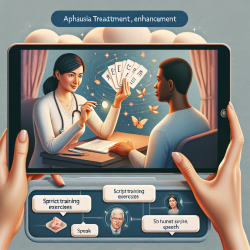Introduction
As a practitioner in speech-language pathology, the quest for improving therapeutic outcomes is perpetual. One of the promising avenues to explore is the integration of advanced neuroimaging techniques into practice. The recent research paper titled A Practical Guide for Combining Functional Regions of Interest and White Matter Bundles offers valuable insights into this integration, particularly through the Functional Sub-Bundles (FSuB) approach. This blog will guide you through the key takeaways from this research and how you can leverage them to enhance your skills and therapy outcomes.
The Power of Functional Sub-Bundles (FSuB)
The FSuB approach is a groundbreaking method that combines functional MRI (fMRI) and diffusion-weighted imaging (DWI) to refine the understanding of brain connectivity. It allows for the precise analysis of white matter bundles connected to functionally defined cortical regions. This precision is crucial in understanding the structural underpinnings of specific cognitive and behavioral functions.
For speech-language pathologists, this means being able to pinpoint the neural pathways involved in language processing and production with greater accuracy. By understanding these pathways, practitioners can tailor interventions more effectively, leading to improved outcomes for children with speech and language disorders.
Implementing FSuB in Practice
Here are some practical steps to implement the FSuB approach in your practice:
- Data Acquisition: Ensure high-quality MRI data acquisition, covering the entire brain with a voxel size of no more than 1mm isotropic. This precision is necessary for accurate cortical surface reconstructions and white matter tractography.
- Data Processing: Utilize software like FreeSurfer for cortical surface reconstruction and MRtrix3 for creating gray matter-white matter interfaces. These tools are essential for projecting functional regions of interest onto the brain's surface accurately.
- FSuB Extraction: Use the FSuB-Extractor, an open-source toolbox introduced in the research, to automate the extraction and analysis of FSuBs. This tool is flexible and can handle various file types for gray matter regions and white matter tractograms.
Encouraging Further Research
The FSuB approach opens numerous avenues for research and clinical applications. By adopting this method, practitioners not only enhance their current practice but also contribute to the growing body of knowledge in neuroimaging and its applications in speech-language pathology.
Encouraging further research in this area can lead to the development of more refined therapeutic techniques, ultimately benefiting children with communication disorders. Practitioners are urged to collaborate with researchers and participate in studies that explore the intricate relationships between brain structure, function, and behavior.
Conclusion
The integration of FSuB into speech-language pathology practice represents a significant advancement in the field. By leveraging this approach, practitioners can achieve more precise and effective interventions, leading to better outcomes for children. The journey to mastering this technique begins with understanding and implementing the insights from the research.
To read the original research paper, please follow this link: A practical guide for combining functional regions of interest and white matter bundles.










